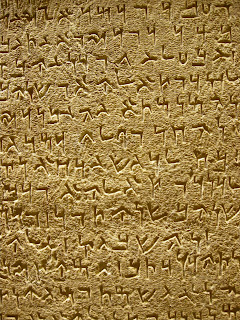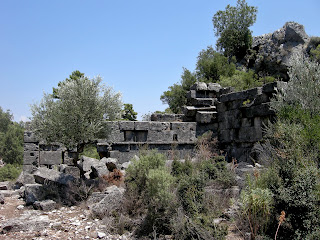Photos by Jack A. Waldron
The goddess Eni Mahanahi was sacred to Lycia and worshipped at the sanctuary now referred to as Letoon before Greek religious culture began its encrouchment on the Xanthus valley during the 4C BC. As is the case today, two Apollonian myths are referred to in regard to 'Lycus', 'wolf' in Greek, which would become the basis of the claim to Apollos' rule over the Xanthus.
As Greek religious culture superseded Lycian religious culture, the Greek goddess Leto would rise to stand in place of Eni Mahanahi. In a possible inverse cultural exchange between Attica and Anatolia, 'Leto' may derive from the Lycian word 'lada', which means 'woman'). To continue, Leto, beloved nymph of Zeus, bore him two children in the sacred sanctuary of Delos, named Apollo and Artemis. This made Leto and her children the despised rivals of Hera, the wife of Zeus, who chased them away to the site now known as Letoon of the Xanthus.
Pictured above, a view of the temple of Leto with the other two temples behind over the Portico (row of columns in the forefront of the photo), and next to the Nympaeum (not pictured and off to the right). Below, the top of a caryatid column found during excavations at Letoon on display in the Fethiye Archeological Museum.
The sanctuary of Letoon was not an occupied city, but the center of the Lycian religious cult where national festivals took place. Letoon was administered by Xanthus, which is located approximately four kilometers north east of the sanctuary.
Three temples are situated next to each other within the sanctuary, the Ionic temple of Leto with standing columns, the central temple, believed to be dedicated to Apollo, and the temple closest to the hill, believed to be that dedicated to Artemis.
Due to a recently discovered mosaic next to the second largest of the temples (pictured above) that feature the lyre of Apollo and the quiver of Artemis, and though there is no certainty, this temple may be dedicated to both Apollo and Artemis, while it is uncertain to which god the centrally located building (the smallest of the three temples) is dedicated.
The temple of Leto has six fluted columns across the front and eleven along its sides. Having been built sometime during the 3C BC, this is considered to be one of the best preserved Greek temple in current day Turkey.
In Metamorphosis, Publius Ovidius Naso (Ovid 43 BC - 18 AD) writes of Letoon,'an ancient altar black with the fires of many sacrifices, surrounded with shivering reeds'.
Pictured above and below, the fluted columns rise from the back of the temple of Leto, while engaged half columns climb the walls of the cella.
The temple sits several meters above an active spring which was accessed by a flight of stars that led worshippers to a sacred pool, here votives and statuettes dating back to 5C BC have been excavated.
A section of the elaborately sculpted Sima (pictured above) attests to the importance of the shrine, as well as the wealth it generated through its festivals, sacrifices and other religious events.
Uniquely ornamented Ionic capitals are on display alongside the temples they once supported. Like a finger print or an iris scan, a site can be known simply by viewing the building members of the monuments at any given site.
Pictured above, a capital sculpted for an engaged corner half column of the cella, while below, a section of a frieze with motifs of a blooming flower and a bulls head, sits atop an architrave.
Based on a nearby inscription in Lycian on a rock face (pictured in the left of the photo below) and flanked by steps near the second largest temple located closest to the natural hill that reads, 'Ertemi', or 'Artemis', that would suggest that this is the temple of Artemis, and also Apollo if we consider the significance of the mosaic.
The second largest of the three temples is pictured above (Temple of Apollo and Artemis), and is dated to sometime during the Hellenistic period. The small temple is pictured sandwiched in the middle on the right in the photo above, and is dated to the 4C BC.
With a dedicatory inscription and ornamentation, a statue base sits next to the temple of Apollo and Artemis. The holes where iron mounts would have secured the statue to the top of the block base can be seen. Pictured below and a bit difficult to discern under the standing water, is the left side of the Nymphaeum with the church in the top left of the photo.
The earlier Hellenistic Nymphaeum was rectangular in shape, the left side wall of which can be seen in the photo above. The rectangular Hellenistic basin comes forward to meet the newer semicircular addition (veering to the left side of the photo above), the junction of which can be seen an exedrae shaped niche, which in ancient times had statues on display. It is within the niche on the west side of the Nympaeum where a dedication to Hadrian can be seen. Again, the Church is located in the top left of the photo.
One of the most important discoveries within the land once under the tutelage of the Lycians is the Letoon Trilingual Stele, sometimes referred to as the Xanthus Trilingual, but not to be confused with the Xanthus Bilingual. The Letoon Trilingual Stele (pictured below) is on display at the Fethiye Archeological Museum.
Pictured below, the Lycian inscription, consisting of 41 lines, and was key to the decipherment of the ancient Lycian language.
Pictured below, the Greek inscription, consisting of 35 lines, it's importance due to the prominance of the use of Greek throughout the region.
Pictured below, the Aramaic inscription, which consists of 27 lines, and was the official language of the Persian empire.
The trilingual inscription on the Xanthus/Letoon Trilingual stone block allowed the Lycian language to be transcribed for the first time.
Situated directly opposite the remnants of the Nympaeum is an late 4C AD Church (pictured below), which was constructed using cut stone from other monuments and sits atop a section of the Nymphaeum toward the eastern side.
Inscribed stele, such as the one pictured below, were repurposed in the construction of the church (the stele pictured below can be seen as forming part of the church wall in the above photo, along with several others.
Just behind the church nestled against the natural hill is what appears to be a dedicatory monument featuring lion claw step decoration (pictured above and below).
The large Hellenistic Theater is located on the northern end of the site. Though the stage building is missing, and is mostly scattered throughout the site as repurposed blocks for other constructions, the monument is in a remarkable state of preservation.
The northern and southern cavea entrances are quite unique when compared to other Hellenistic theaters.
The temple type facade may be an ode to Dionysus, as ancient theaters more often than not were graced with the presence of an actual temple dedicated to Dionysus within the vicinity of the theater building.
I was not to discover until a later date that the outer facade of the northern entrance (the inner side of which can be seen half way up the diazoma in the opposite side of the photo below) is decorated with reliefs of the masks of Dionysus, a satyr, Silenus and a girl.
As I cycle long distances to the ancient cities, time is often a heavy burden, and along with the intense heat of the sun, certain small aspects or features within these ancient cities are often missed, overlooked or bypassed. It is later, when I am writing on these visits that I discover my regrets, which prompts me to declare, 'I now must revisit that site again . . . '.
The central section of the diazoma is carved out of the bedrock on the natural hillside. The Theater was expanded upon during the 2C AD with the grand entrances being added on the north and south at that time.
The theater capacity should be estimated to accommodate some 15-20 thousand people.
As Letoon has been designated as a UNESCO site, money has become available for the preservation and reconstruction of various monuments. Pictured below, newly sculpted arch members are being readied for reimplementation into the theater structure.
Pictured below, an original relief of a helmet from the theater building.
A cool classic motorcycle parked along the road to Letoon. The are many of the around Turkey, and it makes me wish I was still riding, as I surely ould buy one!!
*All photos and content property of Jack A. Waldron (photos may not be used without written permission)
**Please support my work and future postings through PATREON:
Or, make a Donation through PayPal:











































































































